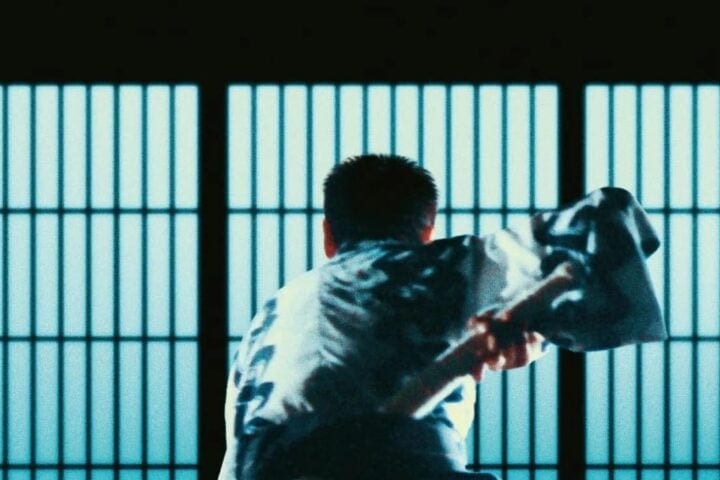Sergio Martino’s Torso may not achieve the sustained delirium of Mario Bava and Dario Argento’s best work, but it’s still a top-shelf giallo. Martino directs with panache, deploying lots of slow zooms, putting the camera in odd positions, and cheekily toying with POV shots. What’s more, Torso foregrounds a motif that recurs throughout the giallo: the interpenetration of sex, violence, and art.
In the opening scene, a professor lectures his distracted students on Pietro Perugino’s portrait of an arrow-pierced Saint Sebastian. While the professor drones on, the camera slinks around the ornate auditorium, catching the students’ exchanged glances and longing looks, hinting at the erotic appeal that can be unleashed by visual depictions of violence. Later, the evidence from a murder scene will be projected before the students in the same manner as the Perugino: art as murder, murder as art. As it turns out, the killer’s pent-up murderous rage may have been unleashed by the act of watching scantily clad coeds strutting their stuff around the university town.
Instead of laying the blame for the crimes squarely on the shoulders of one abnormal individual, Martino and co-writer Ernesto Gastaldi introduce a series of lecherous, potentially criminal types, every one of them ostensibly red-blooded Italian males, who supply a hall of mirrors that refracts the killer’s reductive view of women. Not content with just sticking it to the man, though, Martino and Gastaldi prove equal-opportunity satirists, parodying the sexual revolution’s excesses with a not-so-swinging orgy set in a dilapidated hayloft.
Torso is fascinatingly schizoid. It starts off by exhibiting all the hallmarks of the giallo: a black-gloved killer, protracted set pieces utilizing various methods of murder, and red herrings galore. Then, in its second half, the film morphs into a proto-slasher that bears traces of films as diverse as Alfred Hitchcock’s Psycho and Richard Fleischer’s See No Evil. Torso is also split in terms of setting, starting off in urban Perugia, then taking off into the countryside as American student Jane (Suzy Kendall) retreats to a hilltop villa owner by her uncle to avoid being sliced to bits.
Jane wakes up one morning to find that her friends have been murdered in the night. To make matters even worse, the killer is still stalking around the villa, doing some not-so-nice things to her friends’ remains with a hacksaw. In a bravura sequence that runs nearly 20 minutes, containing practically no dialogue, and including a particularly clever bit involving a key and a newspaper, Jane engages the killer in a nerve-racking game of cat-and-mouse. Throughout the scene, Martino ratchets up the tension with effortless precision through an expressive score, creatively off-center framing, sinuous camera movement, and looming close-ups.
For a Martino film, Torso displays an unexpected kinship with the psychosexual underpinnings of an Argento giallo. Like Tenebrae, the film reveals the killer’s motivation in a flashback to a childhood memory that explains the source of his sexual aberration. But here the killer’s unmasking is rendered almost laughable by the obvious use of a dummy as stand-in for the killer taking a fall, not to mention his vehemently repeated verdict on all women: “Bitches!”
As it turns out, Jane isn’t your slasher final girl. Though she exhibits the archetypal resilience, as well as traces of the virginal “good girl,” she still has to be rescued by dashing doctor Roberto (Luc Merenda) in a last-minute intervention. So the film seems about to shut down rather conventionally, except for the fact that Martino still makes time for some subversion.
After the climactic cliff-side showdown in which somebody falls to his death, we see a figure coming toward Jane in long shot. The figure resembles the killer, but in the next shot it’s revealed to be the hero who made it back alive. This is a subliminal sort of bait-and-switch that blurs the boundary between the two men. The equation is made even more explicit a moment later, when Jane compares Roberto’s use of the word “providence” to the killer’s laying the blame for his murders at the doorstep of “chance and necessity.” That’s precisely the sort of moral equivalence that fueled many of Hitchcock’s films. Even if Torso does little more than toy with the notion, it adds to the overall sense of playfulness in a fascinating film that manages to straddle the boundaries between the giallo and the slasher film.
Image/Sound
Arrow Video’s 2160p UHD transfer of Torso, sourced from the original 35mm camera negative, looks phenomenal. Colors are rich and vivid; grain levels never get too chunky; and the HDR ensures that details remain sharp and clear, especially in the low-light sequences like the climactic fistfight and the vanquishing of the villain. Audio comes in Italian and English LPCM mono. The longer director’s cut has some Italian with English subtitles interspersed throughout. Both options sound fine, and do right by the De Angelis brothers’ rousing score, but, as is often the case, the English dub better duplicates the original theatrical experience.
Extras
Kat Ellinger, author of All the Colours of Sergio Martino, contributes an excellent commentary track that succinctly covers Sergio Martino’s career, closely examines his contributions to the giallo genre, describes his working relationship with producer Carlo Ponti, and discusses Suzy Kendall’s place in both British and Italian cult cinema. Then there are on-camera interviews with Sergio Martino, actor Luc Merenda, screenwriter Ernesto Gastaldi, filmmaker Federica Martino (Sergio’s daughter), and Mikel J. Koven, author of La Dolce Morte: Vernacular Cinema and the Italian Giallo Film. Highlights include Merenda’s recollections of various collaborators, Gastaldi’s description of his early career, and Koven’s explanation of the differences between the giallo and the slasher film. Also included is a Q&A from the 2017 Abertoir International Horror Festival, where Martino discusses both his own films and Italian cinema in general.
Overall
Torso is a top-shelf giallo that also clearly paved the way for the rise of the slasher film.
Since 2001, we've brought you uncompromising, candid takes on the world of film, music, television, video games, theater, and more. Independently owned and operated publications like Slant have been hit hard in recent years, but we’re committed to keeping our content free and accessible—meaning no paywalls or fees.
If you like what we do, please consider subscribing to our Patreon or making a donation.


